|
Printables |
PowerPoints |
Online exercises |
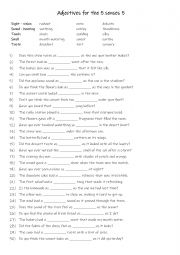
|
A2+-B1 Adjectives for the 5 senses 5
Students should learn sensory adjectives to expand their descriptive vocabulary and enhance their communication skills. These words enable vivid and engaging descriptions, bringing writing and speech to life with clarity and detail. Adjectives like "picturesque," "deafening," or "tangy" help students express nuanced observations, while emotive term...
Level: elementary
Age: 9-100
Type: worksheet
Downloads: 133
|
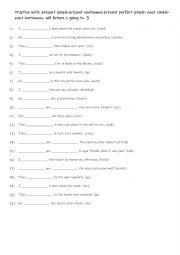
|
A2+-B1 Practise with present simple-present continuous-present perfect simple- past simple-past continuous- will future & going to 3
These tenses help students describe routines, ongoing events, past experiences, and future plans clearly and accurately. Mastery of these tenses improves communication, making it easier to talk about the present, past, and future in both every day and professional contexts. First, students need to familiarise themselves with the tenses and use. The...
Level: elementary
Age: 8-100
Type:
Downloads: 119
|
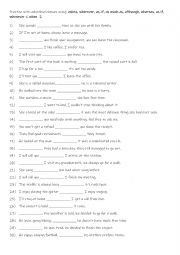
|
A2+-B1 10 adverbial clauses 2
Learning adverbial clauses using words like unless, wherever, as, if, as much as, although, whereas, as if, whenever and when helps students express complex relationships between ideas, such as condition, time, contrast, and manner. These clauses enrich their communication by allowing them to create detailed and nuanced sentences. Mastering these s...
Level: elementary
Age: 9-100
Type:
Downloads: 120
|
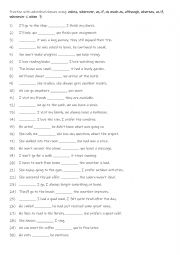
|
A2+-B1 10 Adverbial clauses 3
Learning adverbial clauses using words like unless, wherever, as, if, as much as, although, whereas, as if, whenever and when helps students express complex relationships between ideas, such as condition, time, contrast, and manner. First, students need to familiarise themselves with the 10 adverbial clauses and their use. Then they read the senten...
Level: intermediate
Age: 10-100
Type:
Downloads: 123
|
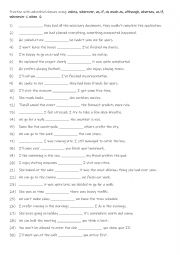
|
A2+-B1 10 Adverbial clauses 6
Learning adverbial clauses using words like unless, wherever, as, if, as much as, although, whereas, as if, whenever and when helps students express complex relationships between ideas, such as condition, time, contrast, and manner. First, students need to familiarise themselves with the 10 adverbial clauses and their use. Then they read the senten...
Level: elementary
Age: 9-100
Type:
Downloads: 118
|
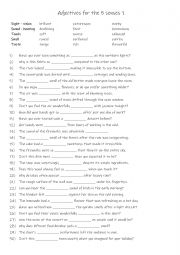
|
A2+-B1 15 adjectives for the 5 senses 1
Students should learn sensory adjectives to expand their descriptive vocabulary and enhance their communication skills. These words enable vivid and engaging descriptions, bringing writing and speech to life with clarity and detail. Adjectives like "picturesque," "deafening," or "tangy" help students express nuanced observations, while emotive term...
Level: elementary
Age: 8-100
Type:
Downloads: 110
|
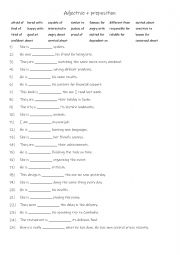
|
A2+-B1 25 Adjective + prepositions
Understanding how adjectives combine with prepositions helps students provide more detailed and precise descriptions. For example, knowing the phrase �interested in� allows you to convey specific interests more clearly.Mastering these combinations contributes to overall language proficiency, allowing you to use English more accurately and confident...
Level: intermediate
Age: 10-100
Type:
Downloads: 117
|
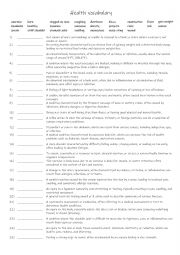
|
A2+-B1 25 Health vocabulary words
Students familiarise themselves with the 25 health related words and their meanings. Then they read the definitions and write the word being described in the space provided. Answers on page 2.
Level: elementary
Age: 8-100
Type:
Downloads: 120
|
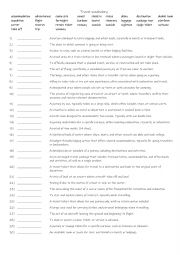
|
A2+-B1 30 travel related words
Students familiarise themselves with the 30 words and their meanings. Then they read the definitions and write the word being described in the space provided. Answers on page 2.
Level: intermediate
Age: 8-100
Type:
Downloads: 111
|
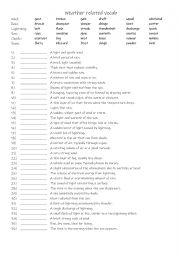
|
A2+-B1 35 weather related words
Students should learn weather-related vocabulary because it improves their ability to describe and discuss weather conditions accurately, which is a common topic in daily conversations and small talk. These words also help students better understand weather forecasts, reports, and natural phenomena, enhancing their listening and reading comprehensi...
Level: intermediate
Age: 10-100
Type:
Downloads: 117
|
|
|
|
|












